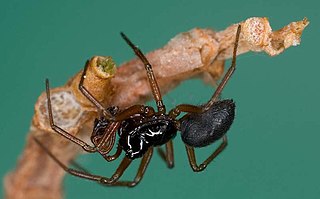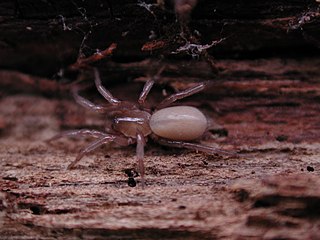
The recluse spiders, also known as brown spiders, fiddle-backs, violin spiders, and reapers, is a genus of spiders that was first described by R. T. Lowe in 1832. They are venomous spiders known for their bite, which sometimes produces a characteristic set of symptoms known as loxoscelism.

The Agelenidae are a large family of spiders in the suborder Araneomorphae. Well-known examples include the common "grass spiders" of the genus Agelenopsis. Nearly all Agelenidae are harmless to humans, but the bite of the hobo spider may be medically significant, and some evidence suggests it might cause necrotic lesions, but the matter remains subject to debate. The most widely accepted common name for members of the family is funnel weaver.

Crevice weaver spiders (Filistatidae) comprise cribellate spiders with features that have been regarded as "primitive" for araneomorph spiders. They are weavers of funnel or tube webs. The family contains 18 genera and more than 120 described species worldwide.

Dictynidae is a family of cribellate, hackled band-producing spiders first described by Octavius Pickard-Cambridge in 1871. Most build irregular webs on or near the ground, creating a tangle of silken fibers among several branches or stems of one plant.

Metepeira is a genus of orb-weaver spiders first described by F. O. Pickard-Cambridge in 1903. The name is derived from the Ancient Greek μετά and the obsolete genus name Epeira, denoting a genus similar to Epeira.

Erigone is a genus of dwarf spiders that was first described by Jean Victoire Audouin in 1826. They are carnivorous, preying on small insects such as Psylla and flies. One of the distinctive characters for this genus is the presence of teeth bordering the carapace.

Cicurina, also called the cave meshweaver, is a genus of dwarf sheet spiders that was first described by Anton Menge in 1871. Originally placed with the funnel weavers, it was moved to the Dictynidae in 1967, then to the Hahniidae in 2017. The name is from the Latin root "cucur-", meaning "to tame".

Dictyna is a genus of cribellate araneomorph spiders in the family Dictynidae, and was first described by Carl Jakob Sundevall in 1833.
Spirembolus is a genus of North American sheet weavers that was first described by Ralph Vary Chamberlin in 1920.

Cybaeota is a genus of North American araneomorph spiders in the family Cybaeidae, and was first described by R. V. Chamberlin & Wilton Ivie in 1933. It was moved to the Cybaeidae in 1967.

Blabomma is a genus of araneomorph spiders in the family Cybaeidae, and was first described by R. V. Chamberlin & Wilton Ivie in 1937. Originally placed with the funnel weavers, it was moved to the Dictynidae in 1967, and to the Cybaeidae in 2017.
Yorima is a genus of araneomorph spiders in the family Cybaeidae and was first described by R. V. Chamberlin & Wilton Ivie in 1942. Originally placed in the funnel weaver family, it was moved to the Dictynidae in 1967, and to the Cybaeidae in 2017.

Filistatinella is a genus of North American crevice weavers that was first described by Willis J. Gertsch & Wilton Ivie in 1936. They are 1.5 to 3.5 millimetres long, and have a dark brown abdomen, longer than wide, with a few gray scales.
Dirksia is a genus of araneomorph spiders in the family Cybaeidae, and was first described by R. V. Chamberlin & Wilton Ivie in 1942 as a subgenus of Ethobuella. Originally placed with the funnel weavers, it was elevated to genus and moved to the dwarf sheet spiders in 1967, then moved to the Cybaeidae in 2017. As of May 2019 it contains only two species: D. cinctipes and D. pyrenaea.
Ethobuella is a genus of North American araneomorph spiders in the family Cybaeidae, and was first described by R. V. Chamberlin & Wilton Ivie in 1937. As of May 2019 it contains only two species: E. hespera and E. tuonops. Originally placed with the funnel weavers, it was elevated to genus and moved to the dwarf sheet spiders in 1967, then moved to the Cybaeidae in 2017.

Strotarchus is a genus of araneomorph spiders in the family Cheiracanthiidae that was first described by Eugène Louis Simon in 1888. Originally added to the Clubionidae, it was moved to the Miturgidae in 1967, and to the Cheiracanthiidae in 2014. It is considered a senior synonym of Marcellina and Coreidon.

Phrurotimpus is a genus of araneomorph spiders first described by R. V. Chamberlin and Wilton Ivie in 1935. The name is a compound adjective meaning "guarding the stone". Originally added to the Liocranidae, it was moved to the Corinnidae in 2002, then to the Phrurolithidae in 2014. They have red egg sacs that look like flattened discs, often found on the underside of stones.
Piabuna is a genus of North American araneomorph spiders first described by R. V. Chamberlin & Wilton Ivie in 1933. Originally added to the Liocranidae, it was moved to the Corinnidae in 2002, then to the Phrurolithidae in 2014.













